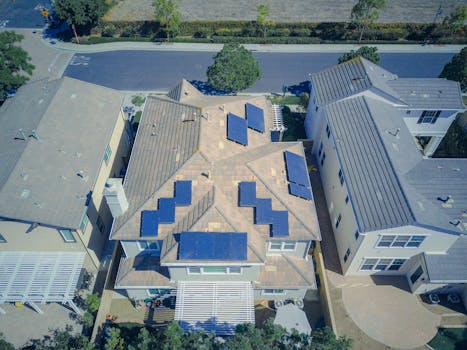“Solar Mounting Systems: Powering Flexibility and Convenience for Temporary Installations.”
Solar mounting systems for temporary installations offer a versatile and convenient solution for harnessing solar energy in various settings. Designed for easy setup and dismantling, these systems cater to short-term projects, events, or emergency power needs. Their lightweight and modular design allows for quick deployment, making them ideal for construction sites, festivals, or disaster relief efforts. With the ability to adapt to different terrains and configurations, temporary solar mounting systems provide a reliable and efficient way to access renewable energy without the long-term commitment of permanent installations. This flexibility not only enhances energy accessibility but also supports sustainability goals by promoting the use of clean energy in diverse applications.
Advantages of Solar Mounting Systems for Temporary Installations
Solar mounting systems designed for temporary installations offer a range of advantages that cater to the evolving needs of various industries and applications. As the demand for renewable energy sources continues to rise, the flexibility and convenience provided by these systems have become increasingly important. One of the primary benefits of solar mounting systems for temporary setups is their ease of installation. Unlike traditional fixed systems, which often require extensive groundwork and permanent fixtures, temporary solar mounts can be quickly assembled and disassembled. This feature is particularly advantageous for projects with limited timelines or those that require frequent relocation, such as construction sites, events, or emergency response scenarios.
Moreover, the lightweight materials used in many temporary solar mounting systems contribute to their portability. These systems are designed to be easily transported, allowing users to deploy solar energy solutions in various locations without the burden of heavy equipment. This portability not only enhances the practicality of solar energy use but also reduces transportation costs and logistical challenges. As a result, organizations can harness solar power in remote areas or during temporary events, ensuring that energy needs are met without the need for extensive infrastructure.
In addition to their ease of use, temporary solar mounting systems are often designed with adaptability in mind. Many of these systems can accommodate different types of solar panels, allowing users to select the most suitable technology for their specific needs. This adaptability extends to the ability to adjust the angle and orientation of the panels, optimizing energy capture based on the sun’s position. Consequently, users can maximize their energy output, even in temporary setups, which is crucial for projects that rely on consistent power supply.
Another significant advantage of temporary solar mounting systems is their cost-effectiveness. By eliminating the need for permanent installations, organizations can save on both initial investment and ongoing maintenance costs. This financial flexibility is particularly beneficial for businesses or projects with limited budgets, as it allows them to invest in renewable energy without incurring substantial expenses. Furthermore, the ability to rent or lease these systems adds another layer of financial convenience, enabling users to access solar technology without the long-term commitment associated with permanent installations.
The environmental benefits of temporary solar mounting systems cannot be overlooked either. By utilizing renewable energy sources, organizations can significantly reduce their carbon footprint, even during short-term projects. This commitment to sustainability not only enhances corporate social responsibility but also aligns with the growing consumer demand for environmentally friendly practices. As more businesses recognize the importance of sustainability, the adoption of temporary solar solutions becomes a strategic advantage in a competitive market.
Finally, the versatility of temporary solar mounting systems extends beyond traditional applications. They can be employed in various sectors, including agriculture, disaster relief, and outdoor events, showcasing their broad applicability. This versatility ensures that organizations can leverage solar energy in diverse contexts, further promoting the transition to renewable energy sources.
In conclusion, the advantages of solar mounting systems for temporary installations are manifold, encompassing ease of installation, portability, adaptability, cost-effectiveness, environmental benefits, and versatility. As the world increasingly shifts towards sustainable energy solutions, these systems provide a practical and efficient means of harnessing solar power, making them an invaluable asset for a wide range of applications. By embracing these innovative solutions, organizations can not only meet their energy needs but also contribute to a more sustainable future.
Key Features of Flexible Solar Mounting Solutions
In the realm of renewable energy, solar mounting systems designed for temporary installations have gained significant traction due to their inherent flexibility and convenience. These systems are engineered to adapt to various environments and requirements, making them an ideal choice for projects that demand mobility and quick deployment. One of the key features of flexible solar mounting solutions is their lightweight construction. Unlike traditional mounting systems, which can be cumbersome and difficult to transport, these innovative designs prioritize portability. This characteristic not only facilitates easier installation but also allows for rapid relocation, which is particularly beneficial for temporary projects such as events, construction sites, or emergency power needs.
Moreover, the versatility of these mounting systems cannot be overstated. They are often compatible with a wide range of solar panel sizes and types, enabling users to customize their setups according to specific energy requirements. This adaptability is crucial, especially in temporary installations where energy demands may fluctuate. By accommodating various solar panel configurations, these systems ensure that users can maximize their energy output without being constrained by rigid mounting options. Additionally, many flexible solar mounting solutions incorporate adjustable features that allow for optimal angling and positioning of solar panels. This adjustability is essential for capturing the maximum amount of sunlight, thereby enhancing the overall efficiency of the solar energy system.
Another significant advantage of flexible solar mounting systems is their ease of installation. Many of these solutions are designed with user-friendly features that simplify the setup process. For instance, some systems utilize pre-assembled components or tool-free assembly mechanisms, which drastically reduce the time and labor required for installation. This ease of use is particularly advantageous for temporary projects where time is often of the essence. Furthermore, the straightforward installation process minimizes the need for specialized skills or extensive training, making it accessible for a broader range of users.
In addition to their practical benefits, flexible solar mounting systems are often designed with durability in mind. Despite their lightweight nature, many of these solutions are constructed from robust materials that can withstand various environmental conditions. This resilience is crucial for temporary installations that may be exposed to harsh weather or challenging terrains. By ensuring that the mounting systems can endure such conditions, users can have confidence in the reliability and longevity of their solar energy solutions, even in temporary setups.
Furthermore, the aesthetic appeal of flexible solar mounting systems should not be overlooked. Many designs prioritize a sleek and unobtrusive appearance, allowing them to blend seamlessly into their surroundings. This is particularly important for temporary installations in public spaces or events where visual impact is a consideration. By offering a visually appealing solution, these mounting systems enhance the overall experience for users and onlookers alike.
Lastly, the cost-effectiveness of flexible solar mounting solutions adds to their allure. Given their ability to be reused across multiple projects, these systems can provide significant savings over time. Users can invest in a single mounting solution that meets their diverse needs, rather than purchasing multiple systems for different applications. This economic advantage, combined with their flexibility and convenience, positions flexible solar mounting systems as a compelling choice for anyone looking to harness solar energy in temporary installations. As the demand for renewable energy continues to grow, the importance of adaptable and efficient solutions will only become more pronounced, making these mounting systems an essential component of the solar landscape.
Best Practices for Installing Temporary Solar Mounting Systems
When it comes to installing temporary solar mounting systems, best practices play a crucial role in ensuring both efficiency and safety. These systems are designed to be flexible and convenient, allowing for quick deployment and removal, which is essential for projects that require mobility or are of a short duration. To achieve optimal performance and reliability, it is important to follow a set of guidelines that address various aspects of the installation process.
First and foremost, site assessment is a critical step in the installation of temporary solar mounting systems. Before any equipment is set up, it is essential to evaluate the location for factors such as sunlight exposure, wind conditions, and potential obstructions. By conducting a thorough site analysis, installers can determine the most effective positioning for solar panels, maximizing energy capture while minimizing risks associated with environmental factors. This proactive approach not only enhances the efficiency of the solar system but also contributes to the longevity of the installation.
Once the site has been assessed, the next step involves selecting the appropriate mounting system. Temporary installations often require lightweight and portable solutions that can be easily assembled and disassembled. Therefore, choosing a mounting system that is specifically designed for temporary use is vital. These systems typically feature modular components that allow for quick setup and takedown, making them ideal for projects that may need to relocate frequently. Additionally, it is important to ensure that the chosen mounting system complies with local regulations and safety standards, as this will help avoid potential legal issues and ensure the safety of the installation.
After selecting the right mounting system, attention must be given to the installation process itself. Proper anchoring is essential for maintaining stability, especially in areas prone to high winds or adverse weather conditions. Utilizing ballast weights or ground anchors can provide the necessary support to keep the solar panels securely in place. Furthermore, installers should ensure that all components are tightly fastened and that connections are secure to prevent any movement or damage during operation. Regular inspections during the installation process can help identify any potential issues early on, allowing for timely adjustments.
In addition to physical stability, it is also important to consider the electrical aspects of the installation. Temporary solar mounting systems should be equipped with appropriate wiring and connections that can withstand the rigors of temporary use. Using weather-resistant materials and ensuring that all electrical components are properly insulated will help prevent failures and enhance the overall reliability of the system. Moreover, it is advisable to implement a monitoring system that can track the performance of the solar installation, providing valuable data that can inform future projects.
Finally, once the temporary solar mounting system has been installed, proper maintenance is key to ensuring its continued performance. Regular checks for debris accumulation, wear and tear, and electrical connections can help identify issues before they escalate. Additionally, documenting the installation process and any maintenance performed can provide valuable insights for future temporary installations, allowing for continuous improvement in practices.
In conclusion, adhering to best practices for installing temporary solar mounting systems is essential for achieving flexibility and convenience while ensuring safety and efficiency. By conducting thorough site assessments, selecting appropriate mounting systems, ensuring proper installation and maintenance, and monitoring performance, installers can create reliable solar solutions that meet the demands of temporary projects. This approach not only maximizes energy production but also sets the stage for successful future installations.
Case Studies: Successful Temporary Solar Installations Using Mounting Systems
In recent years, the demand for temporary solar installations has surged, driven by the need for flexible energy solutions in various sectors. These installations often require innovative mounting systems that can be easily deployed, adjusted, and removed as needed. Several case studies illustrate the successful application of these systems, showcasing their versatility and convenience in diverse environments.
One notable example is the use of temporary solar mounting systems at music festivals. Events like Coachella and Glastonbury have increasingly turned to solar energy to power stages, lighting, and vendor areas. In these scenarios, companies have employed ground-mounted solar arrays that can be quickly assembled and disassembled. These systems typically utilize lightweight aluminum frames and modular components, allowing for rapid setup and takedown. The flexibility of these mounting systems not only meets the immediate energy needs of the festival but also minimizes the environmental impact by reducing reliance on diesel generators. By harnessing solar power, these events can promote sustainability while providing a reliable energy source.
Another compelling case study involves the deployment of solar panels in disaster relief efforts. After natural disasters, such as hurricanes or earthquakes, access to reliable electricity can be severely compromised. Temporary solar installations have proven invaluable in these situations. For instance, in the aftermath of Hurricane Maria in Puerto Rico, organizations utilized portable solar mounting systems to provide power to critical facilities, including hospitals and emergency shelters. These systems were designed for quick installation, allowing responders to set up solar arrays in a matter of hours. The ability to adapt to the changing landscape and immediate needs of affected communities underscores the convenience of temporary solar mounting solutions.
Moreover, construction sites have also benefited from temporary solar installations. As construction projects often have fluctuating energy demands, utilizing solar power can significantly reduce costs and reliance on traditional energy sources. For example, a large-scale construction project in California implemented a temporary solar mounting system to power tools and equipment on-site. The system was designed to be easily relocated as the project progressed, ensuring that energy needs were met without the hassle of permanent installations. This approach not only provided a sustainable energy source but also demonstrated the practicality of solar technology in dynamic environments.
In addition to these examples, educational institutions have explored temporary solar installations for various events and initiatives. Universities and colleges have hosted solar-powered workshops and seminars, utilizing portable mounting systems to create temporary solar arrays on campus. These installations serve dual purposes: they provide energy for the events while also educating students and the community about renewable energy technologies. The ease of setup and removal allows institutions to experiment with solar energy without committing to permanent infrastructure, fostering a culture of sustainability and innovation.
In conclusion, the case studies of temporary solar installations highlight the flexibility and convenience of modern solar mounting systems. From music festivals to disaster relief and construction sites, these systems have proven their worth in diverse applications. As the demand for renewable energy solutions continues to grow, the ability to deploy temporary solar installations will play a crucial role in meeting energy needs while promoting sustainability. The successful implementation of these systems not only demonstrates their practicality but also paves the way for a more adaptable and resilient energy future.
Q&A
1. **What are solar mounting systems for temporary installations?**
Solar mounting systems for temporary installations are structures designed to securely hold solar panels in place for short-term use, such as at events, construction sites, or emergency power needs.
2. **What advantages do temporary solar mounting systems offer?**
They provide flexibility in installation and removal, allowing for quick deployment and relocation, as well as ease of setup without the need for permanent fixtures.
3. **How do temporary solar mounting systems ensure stability?**
These systems often use weighted bases, ground screws, or portable frames to maintain stability while accommodating various terrains and weather conditions.
4. **Can temporary solar mounting systems be reused?**
Yes, they are designed for multiple uses, allowing for cost-effective deployment across different locations and projects without significant wear and tear.
Conclusion
Solar mounting systems for temporary installations offer significant flexibility and convenience, allowing for quick deployment and easy relocation as project needs change. Their lightweight design and modular components facilitate rapid setup and dismantling, making them ideal for events, construction sites, or emergency power needs. This adaptability not only enhances operational efficiency but also reduces costs associated with permanent installations, making temporary solar solutions a practical choice for various applications. Overall, the versatility of these systems supports the growing demand for sustainable energy solutions in dynamic environments.




